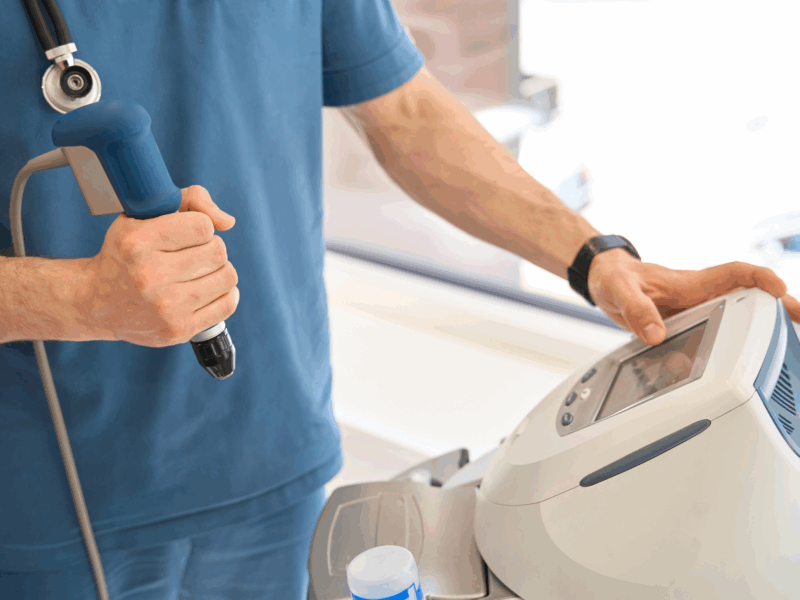What Is Shockwave Therapy?
Shockwave therapy delivers controlled acoustic waves to injured soft tissue using a handheld applicator. These waves stimulate a local healing response that can increase blood flow, modulate pain, influence cellular activity, and, in some shoulder cases, help disrupt calcific deposits. Clinicians use two modalities:
- Focused ESWT (f-ESWT): Concentrates energy at a specific depth; helpful for deeper structures.
- Radial ESWT (r-ESWT): Disperses energy more broadly and superficially; common for muscle trigger points and superficial tendons.
Conditions ESWT May Help
- Plantar fasciitis and plantar heel pain
- Achilles tendinopathy (mid-portion or insertional)
- Lateral/medial epicondylitis (tennis & golfer’s elbow)
- Patellar tendinopathy (“jumper’s knee”)
- Proximal hamstring tendinopathy
- Greater trochanteric pain/gluteal tendinopathy
- Calcific rotator cuff tendinopathy
- Medial tibial stress syndrome (select cases)
- Chronic myofascial trigger points
How a Session Feels & What to Expect
Most treatments last 10–20 minutes. After gel is applied, the provider delivers a set number of pulses. You’ll feel a tapping/pulsing sensation that may be briefly intense, then more tolerable as the area desensitizes. Post-treatment soreness is common for 24–72 hours.
Typical Treatment Plan
- Frequency: Once weekly or every 1–2 weeks
- Sessions: 3–6 typical; up to 8–10 for refractory cases
- Activity: Light daily activity is usually fine; heavy loading is adjusted per your rehab plan
- Timeline: Improvements often build over 4–12 weeks as tissue remodels
Safety & Side Effects
ESWT is noninvasive and generally well-tolerated. Temporary redness, swelling, tenderness, or bruising can occur. Your clinician will review contraindications, which generally include:
- Open wounds, active infection, or tumors at the site
- Over growth plates in skeletally immature patients
- Significant bleeding disorders or anticoagulation (case-by-case)
- Treatment over lungs, brain, or major nerves/vessels
- Pregnancy over the treatment area
- Uncontrolled neuropathy or loss of protective sensation
How ESWT Compares to Other Options
Physical Therapy & Exercise Loading
Progressive loading is foundational for tendinopathy. Shockwave is often layered in when plateaus occur, helping reduce pain so you can train effectively.
Injections
Corticosteroids can provide short-term relief but may not improve tendon quality. Orthobiologics (e.g., PRP) aim to stimulate healing; some clinicians integrate ESWT before or after biologics depending on the case.
Medication
Excessive reliance on anti-inflammatories can blunt tissue adaptation. Follow your provider’s guidance on if/when to use them around ESWT sessions.
Surgery
Reserved for severe, refractory cases. ESWT offers a noninvasive alternative with minimal downtime and a favorable safety profile.
Evidence Snapshot
Research supports ESWT for several chronic tendon conditions—especially plantar fasciitis and calcific shoulder tendinopathy—with growing support for Achilles and lateral elbow pain. Outcomes are strongest when treatment is paired with a structured rehab program, appropriate activity modification, and attention to biomechanics.
Cost & Insurance
Coverage varies by plan and location. Some insurers reimburse ESWT for specific diagnoses after conservative care; others class it as elective. Ask your clinic about pricing, expected sessions, and whether guided exercise programming is included.
Getting the Most from ESWT
Before Your Session
- Arrive well-hydrated; avoid topical creams on the area that day.
- Wear clothing that allows easy access to the treatment site.
After Your Session
- Expect mild soreness for 24–72 hours; use relative rest and gentle mobility as directed.
- Resume progressive loading per your rehab plan; avoid sudden spikes in intensity or volume.
- Track your symptoms with key activities (first steps in the morning, stairs, gripping, jumping) to monitor progress.
Rehab Must-Haves
- Structured loading: Eccentric or heavy-slow resistance tailored to your tendon.
- Mechanics: Address footwear, hip and core strength, or technique errors.
- Recovery: Sleep, nutrition, and stress management support tissue remodeling.
Visit Flow: What Happens
- Assessment: Confirm diagnosis and irritability of the tissue.
- Targeting: Gel application and precise mapping of the most symptomatic area.
- Energy Ramp-Up: Settings adjusted to a therapeutic yet tolerable level.
- Pulses Delivered: Typically 1,500–3,500+ pulses depending on protocol.
- Post-Care: Brief guidance and updates to your exercise progression.
FAQs
Does it hurt?
Mild to moderate, short-lived discomfort is common. Your provider can adjust settings to keep it tolerable.
How fast will I improve?
Some notice relief right away; most gains build over several weeks as the tendon remodels.
Can I exercise after?
Usually yes, with modifications for 24–48 hours. Follow your rehab plan.
Will I need maintenance?
Not always. For high-load athletes or recurring overload, occasional booster sessions may be considered.
Bottom Line
Shockwave therapy offers a noninvasive path to reduce tendon and muscle pain—especially when standard care hasn’t delivered. Paired with a smart rehab plan and load management, it can help you move with less pain and get back to what you love.
This article is educational and not a substitute for personalized medical advice. Talk with a qualified clinician to determine whether ESWT is appropriate for your condition.



 Living with Fibromyalgia? How Laser & Orthobiologic Therapies Can Help
Living with Fibromyalgia? How Laser & Orthobiologic Therapies Can Help
